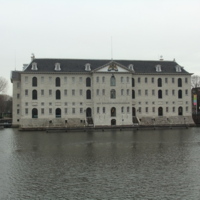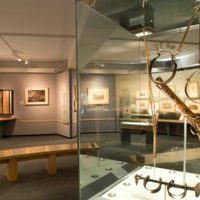
Het Scheepvaartmuseum
Het Scheepvaartmuseum is the National Maritime Museum of the Netherlands. Housed in a seventeenth-century naval storehouse, the museum showcases the ways in which Dutch culture has been influenced by the sea. A vast array of collections, including paintings, maps, maritime instruments and weapons illustrate these stories. Just outside the museum, there is a replica of an eighteenth century ship, the Amsterdam, which once sailed between the Netherlands and the Dutch East Indies. With fifteen permanent exhibitions and a free audio tour, the museum's four million annual visitors are exposed to over five hundred years of both Dutch, and world, history.
Dutch involvement in slave trading is highlighted in the 'See you in the Golden Age' exhibition. The interpretation here focusses on the seventeenth century, a time when the Netherlands was one of the most economically and culturally rich countries in the world. While the exhibition reflects this boom period through a variety of collections, it also illustrates the darker side of Dutch prosperity. By making use of contemporary narratives, the museum provides its visitors a chance 'meet' historical characters including Amimba, a young African girl who was forced into slavery.

National Maritime Museum
The National Maritime Museum is the largest maritime museum in the world. It forms part of the Royal Museums Greenwich UNESCO World Heritage Site. The NMM houses ten galleries that all showcase Britain’s Maritime History. Its mission is 'to enrich people’s understanding of the sea, the exploration of space, and Britain's role in world history’. ‘The Atlantic Worlds Gallery,' launched in 2007 for the commemoration of the bicentenary, charts the interconnections between Britain, Africa and the Americas between 1600 and 1850. The gallery is about the movement of people, goods and ideas across and around the Atlantic Ocean from the 17th century to the 19th century. The connections created by these movements affected people across three continents, impacting on their cultures and communities and shaping the world we live in today. Four main themes are explored within the gallery, including exploration, war, enslavement and resistance. These displays benefited extensively from the museum's purchase of the Michael Graham-Stewart Slavery Collection in 2002. 'Atlantic Worlds' charts the triangular trade through African civilisations, enslavement and the Middle Passage, and the abolition movement. It recounts the stories of some of the people involved in the resistance movement and the campaign for the abolition of the transatlantic slave trade – including Toussaint l’Ouverture, Olaudah Equiano and Samuel Sharp whose acts of resistance and rebellion were crucial to the turning of European public opinion against the trade. Its narrative also goes beyond the achievement of legal abolition in Britain, to include discussions of the Royal Navy's involvement in suppressing the trade world wide.